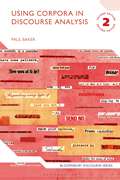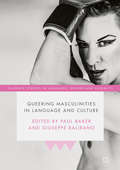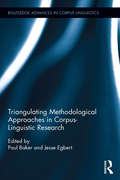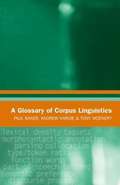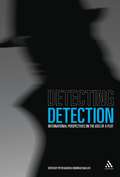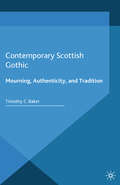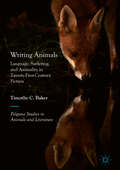- Table View
- List View
Using Corpora in Discourse Analysis (Bloomsbury Discourse)
by Paul BakerHow can you carry out discourse analysis using corpus linguistics? What research questions should I ask? Which methods should you use and when? What is a collocational network or a key cluster? Introducing the major techniques, methods and tools for corpus-assisted analysis of discourse, this book answers these questions and more, showing readers how to best use corpora in their analyses of discourse. Using carefully tailored case studies, each chapter is devoted to a central technique, including frequency, concordancing and keywords, going step by step through the process of applying different analytical procedures. Introducing a wide range of different corpora, from holiday brochures to political debates, the book considers the key debates and latest advances in the field. Fully revised and updated, this new edition includes:- A new chapter on how to conduct research projects in corpus-based discourse analysis- Completely rewritten chapters on collocation and advanced techniques, using a corpus of jihadist propaganda texts and covering topics such as social media and visual analysis- Coverage of major tools, including CQPweb, AntConc, Sketch Engine and #LancsBox- Discussion of newer techniques including the derivation of lockwords and the comparison of multiple data sets for diachronic analysisWith exercises, discussion questions and suggested further readings in each chapter, this book is an excellent guide to using corpus linguistics techniques to carry out discourse analysis.
Using Corpora in Discourse Analysis (Bloomsbury Discourse)
by Paul BakerHow can you carry out discourse analysis using corpus linguistics? What research questions should I ask? Which methods should you use and when? What is a collocational network or a key cluster? Introducing the major techniques, methods and tools for corpus-assisted analysis of discourse, this book answers these questions and more, showing readers how to best use corpora in their analyses of discourse. Using carefully tailored case studies, each chapter is devoted to a central technique, including frequency, concordancing and keywords, going step by step through the process of applying different analytical procedures. Introducing a wide range of different corpora, from holiday brochures to political debates, the book considers the key debates and latest advances in the field. Fully revised and updated, this new edition includes:- A new chapter on how to conduct research projects in corpus-based discourse analysis- Completely rewritten chapters on collocation and advanced techniques, using a corpus of jihadist propaganda texts and covering topics such as social media and visual analysis- Coverage of major tools, including CQPweb, AntConc, Sketch Engine and #LancsBox- Discussion of newer techniques including the derivation of lockwords and the comparison of multiple data sets for diachronic analysisWith exercises, discussion questions and suggested further readings in each chapter, this book is an excellent guide to using corpus linguistics techniques to carry out discourse analysis.
Using Corpora to Analyze Gender
by Paul BakerCorpus linguistics uses specialist software to identify linguistic patterns in large computerised collections of text - patterns which then must be interpreted and explained by human researchers. This book critically explores how corpus linguistics techniques can help analysis of language and gender by conducting a number of case studies on topics which include: directives in spoken conversations, changes in sexist and non-sexist language use over time, personal adverts, press representation of gay men, and the ways that boys and girls are constructed through language. The book thus covers both gendered usage (e.g. how do males and females use language differently, or not, from each other), and gendered representations (e.g. in what ways are males and females written or spoken about). Additionally, the book shows ways that readers can either explore their own hypotheses, or approach the corpus from a "naïve†? position, letting the data drive their analysis from the outset. The book covers a range of techniques and measures including frequencies, keywords, collocations, dispersion, word sketches, downsizing and triangulation, all in an accessible style.
Using Corpora to Analyze Gender
by Paul BakerCorpus linguistics uses specialist software to identify linguistic patterns in large computerised collections of text - patterns which then must be interpreted and explained by human researchers. This book critically explores how corpus linguistics techniques can help analysis of language and gender by conducting a number of case studies on topics which include: directives in spoken conversations, changes in sexist and non-sexist language use over time, personal adverts, press representation of gay men, and the ways that boys and girls are constructed through language. The book thus covers both gendered usage (e.g. how do males and females use language differently, or not, from each other), and gendered representations (e.g. in what ways are males and females written or spoken about). Additionally, the book shows ways that readers can either explore their own hypotheses, or approach the corpus from a “naïve” position, letting the data drive their analysis from the outset. The book covers a range of techniques and measures including frequencies, keywords, collocations, dispersion, word sketches, downsizing and triangulation, all in an accessible style.
Queering Masculinities in Language and Culture (Palgrave Studies in Language, Gender and Sexuality)
by Paul Baker Giuseppe BaliranoHow do we learn what it means to be a man? And how do we learn to question what it means to be a man? This collection comprises a set of original interdisciplinary chapters on the linguistic and cultural representations of queer masculinities in a range of new and older media: television, film, online forums, news reporting, advertising and fiction. This innovative work examines new and emerging forms of gender hybridisation in relation to complex socialisation and immigration contexts including the role of EU institutions in ascertaining asylum seekers’ sexual orientation, and the European laws on gender policy. The book employs numerous analytical approaches including critical discourse analysis, corpus linguistics, multimodal analysis, literary criticism and anthropological and social research. The authors show how such texts can disrupt, question or complicate traditional notions of what it means to be a man, queering the idea that men possess fixed identities or desires, instead arguing that masculinity is constantly changing and negotiated through the cultural and political overlapping contexts in which it is regularly produced. These nuanced analyses will bring fresh insights for students and scholars of gender, masculinity and queer studies, linguistics, anthropology and semiotics.
The Language of Patient Feedback: A Corpus Linguistic Study of Online Health Communication (Routledge Applied Corpus Linguistics)
by Paul Baker Gavin Brookes Craig EvansThe Language of Patient Feedback provides a unique insight into a diverse range of issues related to healthcare. Through the comprehensive and detailed interrogation of 29 million words of online patient feedback on the NHS in England, as well as 11 million words of responses to the feedback from NHS providers, this book: Uses a combination of computer-assisted and human analysis (Corpus-Assisted Discourse Analysis) to examine the extent to which characteristics like age and gender result in different types of evaluation. Investigates why nurses, doctors, dentists and receptionists are associated with very distinct types of feedback. Demonstrates the ways that NHS staff respond to comments and what this reveals about underlying institutional ideologies and practices. Concludes with suggestions for key recommendations that the NHS could act upon to improve the overall level of care it provides, as well as reflecting on what patient evaluation can actually tell us. The Language of Patient Feedback is key reading for anyone undertaking research within corpus linguistics, discourse analysis and health communication.
The Language of Patient Feedback: A Corpus Linguistic Study of Online Health Communication (Routledge Applied Corpus Linguistics)
by Paul Baker Gavin Brookes Craig EvansThe Language of Patient Feedback provides a unique insight into a diverse range of issues related to healthcare. Through the comprehensive and detailed interrogation of 29 million words of online patient feedback on the NHS in England, as well as 11 million words of responses to the feedback from NHS providers, this book: Uses a combination of computer-assisted and human analysis (Corpus-Assisted Discourse Analysis) to examine the extent to which characteristics like age and gender result in different types of evaluation. Investigates why nurses, doctors, dentists and receptionists are associated with very distinct types of feedback. Demonstrates the ways that NHS staff respond to comments and what this reveals about underlying institutional ideologies and practices. Concludes with suggestions for key recommendations that the NHS could act upon to improve the overall level of care it provides, as well as reflecting on what patient evaluation can actually tell us. The Language of Patient Feedback is key reading for anyone undertaking research within corpus linguistics, discourse analysis and health communication.
Triangulating Methodological Approaches in Corpus Linguistic Research (Routledge Advances in Corpus Linguistics)
by Paul Baker Jesse EgbertContemporary corpus linguists use a wide variety of methods to study discourse patterns. This volume provides a systematic comparison of various methodological approaches in corpus linguistics through a series of parallel empirical studies that use a single corpus dataset to answer the same overarching research question. Ten contributing experts each use a different method to address the same broadly framed research question: In what ways does language use in online Q+A forum responses differ across four world English varieties (India, Philippines, United Kingdom, and United States)? Contributions will be based on analysis of the same 400,000 word corpus from online Q+A forums, and contributors employ methodologies including corpus-based discourse analysis, audience perceptions, Multi-Dimensional analysis, pragmatic analysis, and keyword analysis. In their introductory and concluding chapters, the volume editors compare and contrast the findings from each method and assess the degree to which ‘triangulating’ multiple approaches may provide a more nuanced understanding of a research question, with the aim of identifying a set of complementary approaches which could arguably take into account analytical blind spots. Baker and Egbert also consider the importance of issues such as researcher subjectivity, type of annotation, the limitations and affordances of different corpus tools, the relative strengths of qualitative and quantitative approaches, and the value of considering data or information beyond the corpus. Rather than attempting to find the ‘best’ approach, the focus of the volume is on how different corpus linguistic methodologies may complement one another, and raises suggestions for further methodological studies which use triangulation to enrich corpus-related research.
Triangulating Methodological Approaches in Corpus Linguistic Research (Routledge Advances in Corpus Linguistics)
by Paul Baker Jesse EgbertContemporary corpus linguists use a wide variety of methods to study discourse patterns. This volume provides a systematic comparison of various methodological approaches in corpus linguistics through a series of parallel empirical studies that use a single corpus dataset to answer the same overarching research question. Ten contributing experts each use a different method to address the same broadly framed research question: In what ways does language use in online Q+A forum responses differ across four world English varieties (India, Philippines, United Kingdom, and United States)? Contributions will be based on analysis of the same 400,000 word corpus from online Q+A forums, and contributors employ methodologies including corpus-based discourse analysis, audience perceptions, Multi-Dimensional analysis, pragmatic analysis, and keyword analysis. In their introductory and concluding chapters, the volume editors compare and contrast the findings from each method and assess the degree to which ‘triangulating’ multiple approaches may provide a more nuanced understanding of a research question, with the aim of identifying a set of complementary approaches which could arguably take into account analytical blind spots. Baker and Egbert also consider the importance of issues such as researcher subjectivity, type of annotation, the limitations and affordances of different corpus tools, the relative strengths of qualitative and quantitative approaches, and the value of considering data or information beyond the corpus. Rather than attempting to find the ‘best’ approach, the focus of the volume is on how different corpus linguistic methodologies may complement one another, and raises suggestions for further methodological studies which use triangulation to enrich corpus-related research.
Key Terms in Discourse Analysis (Key Terms)
by Paul Baker Sibonile ElleceThis book offers a clearly written and comprehensive set of definitions of key terms in discourse analysis, a core area of all linguistics and language studies courses. Unlike many other areas of linguistics, Discourse analysis is a complex field to define, comprising a number of related but different theoretical and methodological frameworks. Discourse can mean many different things to different people. Students often find these multiple meanings to be confusing and this book attempts to spell out and reconcile the different approaches, to give a holistic picture of Discourse Analysis as a branch of several disciplines. As well as comprising a glossary of key terms, the book provides clear, illustrative examples, a section on key thinkers and their ideas, and key texts for further reading. This book is essential reading for students on linguistics, language studies and media and cultural studies courses who are engaging in discourse analysis. The Key Terms series offers undergraduate students clear, concise and accessible introductions to core topics. Each book includes a comprehensive overview of the key terms, concepts, thinkers and texts in the area covered and ends with a guide to further resources.
A Glossary of Corpus Linguistics (PDF)
by Paul Baker Andrew Hardie Tony MceneryThis alphabetic guide provides definitions and discussion of key terms used in corpus linguistics. Corpus data is being used in a growing number of English and Linguistics departments which have no record of past research with corpus data. This is the first comprehensive glossary of the manyspecialist terms in corpus linguistics and will be useful for corpus linguists and non corpus linguists alike. Clearly written, by a team of experienced academics in the field, the glossary provides full coverage of both traditional and contemporary terminology. 9780748624034
Corpora and Discourse Studies: Integrating Discourse and Corpora (Palgrave Advances in Language and Linguistics #3)
by Paul Baker Tony McEneryThis edited collection brings together contemporary research that uses corpus linguistics to carry out discourse analysis. The book takes an inclusive view of the meaning of discourse, covering different text-types or modes of language, including discourse as both social practice and as ideology or representation.
Introduction to Old English
by Peter S. BakerFeaturing numerous updates and additional anthology selections, the 3rd edition of Introduction to Old English confirms its reputation as a leading text designed to help students engage with Old English literature for the first time. A new edition of one of the most popular introductions to Old English Assumes no expertise in other languages or in traditional grammar Includes basic grammar reviews at the beginning of each major chapter and a “minitext” feature to aid students in practicing reading Old English Features updates and several new anthology readings, including King Alfred’s Preface to Gregory’s Pastoral Care
Introduction to Old English
by Peter S. BakerFeaturing numerous updates and additional anthology selections, the 3rd edition of Introduction to Old English confirms its reputation as a leading text designed to help students engage with Old English literature for the first time. A new edition of one of the most popular introductions to Old English Assumes no expertise in other languages or in traditional grammar Includes basic grammar reviews at the beginning of each major chapter and a “minitext” feature to aid students in practicing reading Old English Features updates and several new anthology readings, including King Alfred’s Preface to Gregory’s Pastoral Care
Detecting Detection: International Perspectives on the Uses of a Plot
by Peter Baker Deborah ShallerWe indulge our fascination with detection in many ways, only some of which occur in the detective story. In fact, modern fiction regularly uses elements of a detective narrative to tell another story altogether, to engage characters, narrators, and readers with questions of identity, with examinations of moral and ethical reasoning, with critiques of social and political injustices, and with the metaphysics of meaning itself. Detective plots cross cultural and national boundaries and occur in different ways and different genres. Taken together, they suggest important contemporary understandings of who and what we are, how and what we aspire to become.Detecting Detection gathers writing from the UK, North and South America, Europe, and Asia to draw together instances of the detective plot in contemporary fiction. It is unique not only in addressing the theme-a recurring one in modern literature-but in tracking the interest in detectives and detection across international borders.
Detecting Detection: International Perspectives on the Uses of a Plot
by Peter Baker Deborah ShallerWe indulge our fascination with detection in many ways, only some of which occur in the detective story. In fact, modern fiction regularly uses elements of a detective narrative to tell another story altogether, to engage characters, narrators, and readers with questions of identity, with examinations of moral and ethical reasoning, with critiques of social and political injustices, and with the metaphysics of meaning itself. Detective plots cross cultural and national boundaries and occur in different ways and different genres. Taken together, they suggest important contemporary understandings of who and what we are, how and what we aspire to become.Detecting Detection gathers writing from the UK, North and South America, Europe, and Asia to draw together instances of the detective plot in contemporary fiction. It is unique not only in addressing the theme-a recurring one in modern literature-but in tracking the interest in detectives and detection across international borders.
The Fiction of Postmodernity (PDF)
by Stephen BakerThe Fiction of Postmodernityis a significant and accessible new study of the relation of postmodern fiction to theories of the postmodern. Contemporary works of fiction by novelists such as Don DeLillo, Toni Morrison, Salman Rushdie, Thomas Pynchon and Martin Amis are viewed in relation to critiques of the 'culture industry', analyses of the 'postmodern condition' and theories of simulacra. The work of influential theorists of the postmodern - such as Theodor Adorno, Jean-François Lyotard, Fredric Jameson and Jean Baudrillard - is explained and compared. The book offers descriptions of the postmodern from both the Marxist critical tradition and from the perspective of postmarxism. Key features in both these definitions are explained in relation to modernist and postmodern works of fiction. Issues relating to the postmodern representation of history and the development of a postmodern politics are also addressed in relation to works of contemporary fiction. Key Features*Substantial readings of fiction by major contemporary authors (e. g. Thomas Pynchon, Salman Rushdie, Don DeLillo)*Introduces influential theories of the postmodern (Fredric Jameson, Jean-François Lyotard, Jean Baudrillard)*Analysis of the relationships of modernism and the avant-garde to postmodernism*Focuses on the critical potential of postmodernism and postmodern fiction
The New nasen A-Z of Reading Resources (nasen spotlight)
by Suzanne Baker Lorraine PetersenThe New nasen A-Z of Reading Resources is a graded list of all current reading schemes complete with guidance on the books’ suitability for readers at different levels of experience and competence. It will: enable teachers, SENCos and support services to choose books that are appropriate yet sufficiently rewarding for struggling readers prove to be a time-saving resource for schools replenishing their reading stock follow up-to-the-minute thinking on ‘readability’. A great resource for all schools - primary and secondary - as well as support services, advisers and literacy consultants.
The New nasen A-Z of Reading Resources (nasen spotlight)
by Suzanne Baker Lorraine PetersenThe New nasen A-Z of Reading Resources is a graded list of all current reading schemes complete with guidance on the books’ suitability for readers at different levels of experience and competence. It will: enable teachers, SENCos and support services to choose books that are appropriate yet sufficiently rewarding for struggling readers prove to be a time-saving resource for schools replenishing their reading stock follow up-to-the-minute thinking on ‘readability’. A great resource for all schools - primary and secondary - as well as support services, advisers and literacy consultants.
Contemporary Scottish Gothic: Mourning, Authenticity, and Tradition (Palgrave Gothic)
by T. BakerAn innovative reading of a wide range of contemporary Scottish novels in relation to literary tradition and modern philosophy, Contemporary Scottish Gothic provides a new approach to Scottish fiction and Gothic literature, and offers a fuller picture of contemporary Scottish Gothic than any previous text.
Sentiment and Celebrity: Nathaniel Parker Willis and the Trials of Literary Fame
by Thomas N. BakerHow did the stately, republican literary world of Washington Irving and James Fenimore Cooper give way to the sensationalist, personality-saturated mass market society of the late nineteenth century? In answering this question, Sentiment and Celebrity tells the story of a man the New York Times once called "the most talked-about author in America." A widely admired, if controversial, master of the sentimental appeal, poet and "magazinist" Nathaniel Parker Willis (1806-1867) was a pioneer in the modern business of celebrity. In his heyday, he knew both popularity and success as few other American writers had. Willis, who became the gossip-dishing darling of the middle class and whose sister was the popular writer Fanny Fern (of Ruth Hall fame), was a shrewdly self-styled man of letters who attained international fame by publicizing the renowned figures of the day, including himself, and by playing to, or playing upon, the sentimental desires of his readers. By the 1840s, he could count himself among the nation's highest paid writers and most influential arbiters of fashion and feeling (especially with genteel women), though he could also describe himself, accurately enough, as one of the "best abused" literary men of his generation. With fame and self-promotion came unexpected, perhaps unforeseeable, burdens, and scandal followed eventually. By charting the various controversies that surrounded Willis, this book shows how the cultural and commercial impulses that fostered antebellum America's new love of fame and fashion drew sustenance from the concurrent allure of genteel cultivation and sentiment. Still, perennial tensions between desires for privacy and the invasive impulses of publicity, and between desires for sincerity and the appeal of social and commercial artifice, rendered this cultural conjunction highly unstable. Readers of Willis were both attracted to and disturbed by his written work and his very person; he introduced new possibilities for fashion, taste, and celebrity, and these new modes of thought and emotion were at once enchanting and unsettling. Because this cultural instability and the impulses that spawned it cut across a number of discourses, and because, in many ways, this double-edged quality remains central to our modern celebrity culture, Sentiment and Celebrity will appeal to students and scholars of several disciplines, among them literary studies, women's studies, sociocultural history, and communication studies. As Thomas N. Baker demonstrates in these fascinating pages, not only does Willis's story enrich our understanding of the early history of celebrity and the development of this country's literary marketplace in the years before the Civil War, it also shows how the cultural phenomena of sentiment and celebrity have gone hand in hand since their inception. Given the countless ways in which fame (literary or otherwise) continues to pervade (and pervert) the American Dream, Baker's book is a "life and times" study that speaks directly to our own lives.
Sentiment and Celebrity: Nathaniel Parker Willis and the Trials of Literary Fame
by Thomas N. BakerHow did the stately, republican literary world of Washington Irving and James Fenimore Cooper give way to the sensationalist, personality-saturated mass market society of the late nineteenth century? In answering this question, Sentiment and Celebrity tells the story of a man the New York Times once called "the most talked-about author in America." A widely admired, if controversial, master of the sentimental appeal, poet and "magazinist" Nathaniel Parker Willis (1806-1867) was a pioneer in the modern business of celebrity. In his heyday, he knew both popularity and success as few other American writers had. Willis, who became the gossip-dishing darling of the middle class and whose sister was the popular writer Fanny Fern (of Ruth Hall fame), was a shrewdly self-styled man of letters who attained international fame by publicizing the renowned figures of the day, including himself, and by playing to, or playing upon, the sentimental desires of his readers. By the 1840s, he could count himself among the nation's highest paid writers and most influential arbiters of fashion and feeling (especially with genteel women), though he could also describe himself, accurately enough, as one of the "best abused" literary men of his generation. With fame and self-promotion came unexpected, perhaps unforeseeable, burdens, and scandal followed eventually. By charting the various controversies that surrounded Willis, this book shows how the cultural and commercial impulses that fostered antebellum America's new love of fame and fashion drew sustenance from the concurrent allure of genteel cultivation and sentiment. Still, perennial tensions between desires for privacy and the invasive impulses of publicity, and between desires for sincerity and the appeal of social and commercial artifice, rendered this cultural conjunction highly unstable. Readers of Willis were both attracted to and disturbed by his written work and his very person; he introduced new possibilities for fashion, taste, and celebrity, and these new modes of thought and emotion were at once enchanting and unsettling. Because this cultural instability and the impulses that spawned it cut across a number of discourses, and because, in many ways, this double-edged quality remains central to our modern celebrity culture, Sentiment and Celebrity will appeal to students and scholars of several disciplines, among them literary studies, women's studies, sociocultural history, and communication studies. As Thomas N. Baker demonstrates in these fascinating pages, not only does Willis's story enrich our understanding of the early history of celebrity and the development of this country's literary marketplace in the years before the Civil War, it also shows how the cultural phenomena of sentiment and celebrity have gone hand in hand since their inception. Given the countless ways in which fame (literary or otherwise) continues to pervade (and pervert) the American Dream, Baker's book is a "life and times" study that speaks directly to our own lives.
New Forms of Environmental Writing: Gleaning and Fragmentation (Environmental Cultures)
by Timothy C. BakerSurveying a wide range of contemporary poetry, fiction, and memoir by women writers, this book explores our most pressing environmental concerns and shows how these texts find innovative new ways to respond to our environmental crisis.Arguing for the centrality of individual encounter and fragmentary form in 21st-century literature, as well as themes of attention, care, and loss, Baker highlights the ways that fragmentary texts can be seen as a mode of resistance. These texts provide new ways to consider the role of individual agency and enmeshment in a more-than-human world.The author proposes a new model of 'gleaning' to encompass ideas of collection, assemblage, and relinquishment and draws on theoretical perspectives such as ecofeminism, new materialism and posthumanism. Examining works by writers including Sara Baume, Ali Smith, Elizabeth-Jane Burnett, Bhanu Kapil and Kathleen Jamie, Baker provides important new insights into understanding our planetary predicament.
New Forms of Environmental Writing: Gleaning and Fragmentation (Environmental Cultures)
by Timothy C. BakerSurveying a wide range of contemporary poetry, fiction, and memoir by women writers, this book explores our most pressing environmental concerns and shows how these texts find innovative new ways to respond to our environmental crisis.Arguing for the centrality of individual encounter and fragmentary form in 21st-century literature, as well as themes of attention, care, and loss, Baker highlights the ways that fragmentary texts can be seen as a mode of resistance. These texts provide new ways to consider the role of individual agency and enmeshment in a more-than-human world.The author proposes a new model of 'gleaning' to encompass ideas of collection, assemblage, and relinquishment and draws on theoretical perspectives such as ecofeminism, new materialism and posthumanism. Examining works by writers including Sara Baume, Ali Smith, Elizabeth-Jane Burnett, Bhanu Kapil and Kathleen Jamie, Baker provides important new insights into understanding our planetary predicament.
Writing Animals: Language, Suffering, and Animality in Twenty-First-Century Fiction (Palgrave Studies in Animals and Literature)
by Timothy C. BakerThis book surveys a broad range of contemporary texts to show how representations of human-animal relations challenge the anthropocentric nature of fiction. By looking at the relation between language and suffering in twenty-first-century fiction and drawing on a wide range of theoretical approaches, Baker suggests new opportunities for exploring the centrality of nonhuman animals in recent fiction: writing animal lives leads to new narrative structures and forms of expression. These novels destabilise assumptions about the nature of pain and vulnerability, the burden of literary inheritance, the challenge of writing the Anthropocene, and the relation between text and image. Including both well-known authors and emerging talents, from J.M. Coetzee and Karen Joy Fowler to Sarah Hall, Alexis Wright, and Max Porter, and texts from experimental fiction to work for children, Writing Animals offers an original perspective on both contemporary fiction and the field of literary animal studies.
